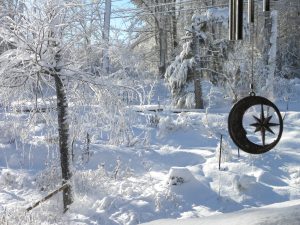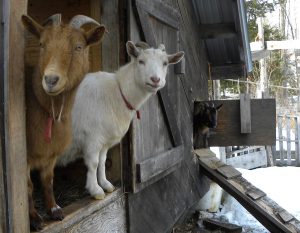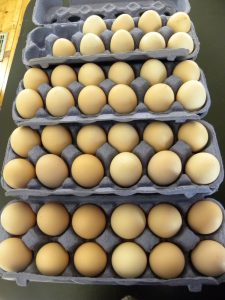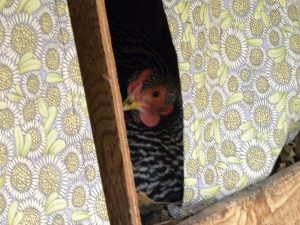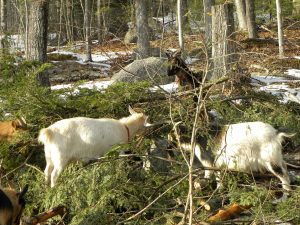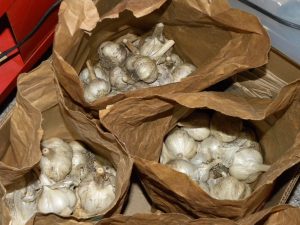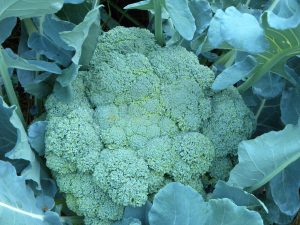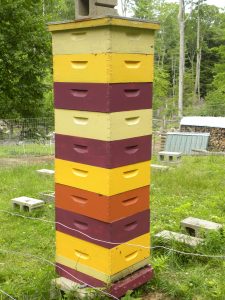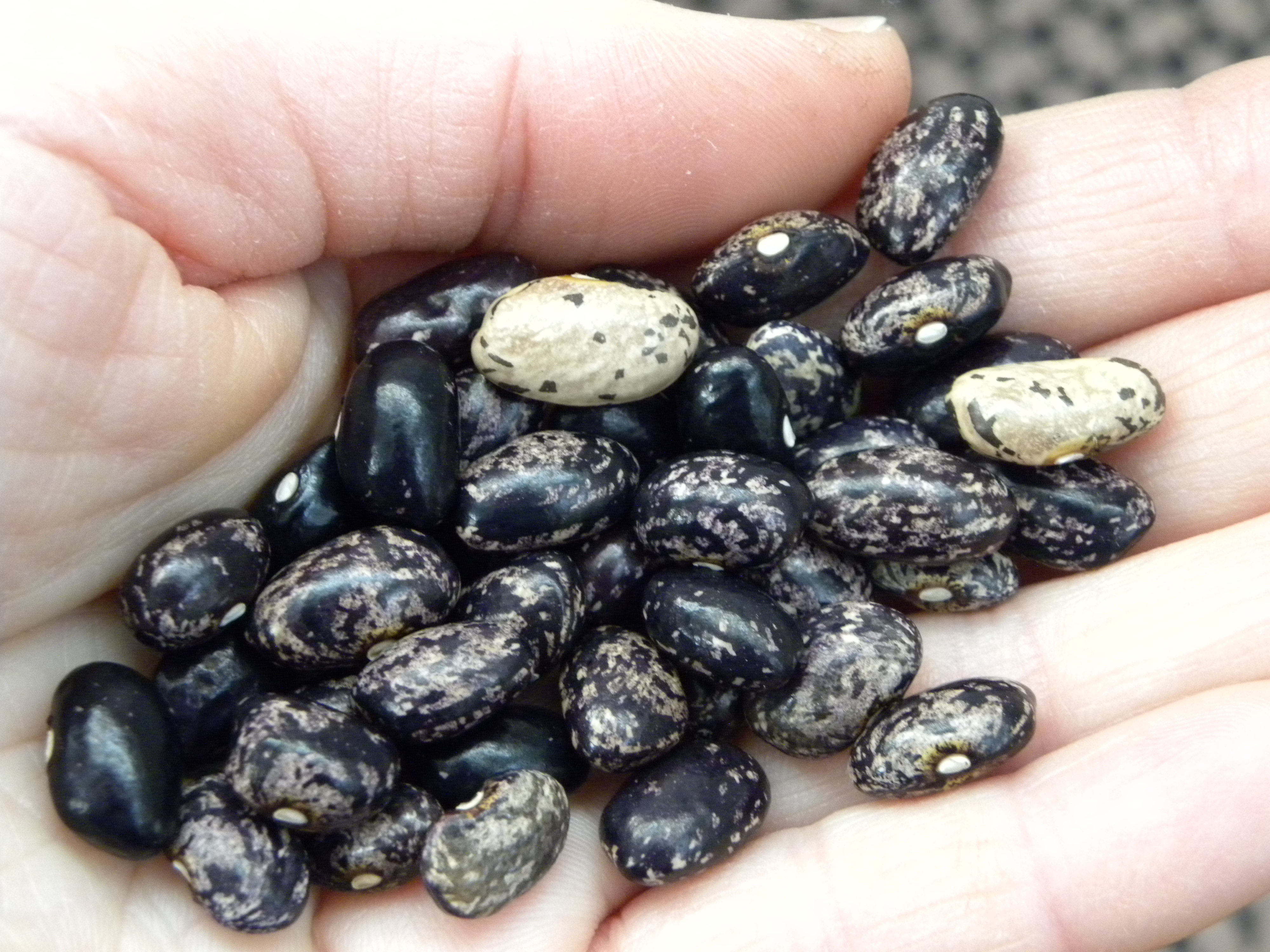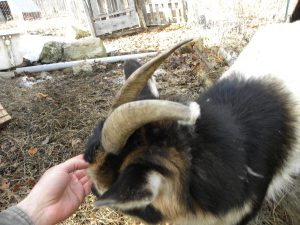
Juniper is Shedding – see her horn tips!
Another winter month on our homestead has passed. It was unusually warm for February, with more rain than snow falling, leading to a mini-mud season, shedding goats and flying bees (video of the bees: Bees Flying – February Thaw 2018). But the days were still short, it’s not spring yet.
Our Work in February
Taking care of livestock happens every day, in every season. Feeding, watering, keeping their bedding fresh, watching out for health problems. Without much snow, the animals had a larger area, venturing out into farther yards. There isn’t much for them to eat out there, but I like it when they can get out and not spend so much time in one area, standing in their own poop.
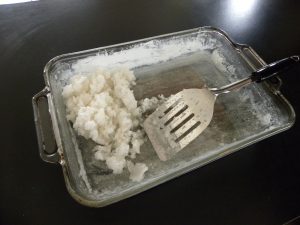
Making Our Own Sea Salt
I have a new project that I am loving – making our own sea salt! When we collected seaweed for the animals recently, we also filled some buckets with water. I ran the water through a strainer to remove bits of seaweed and sand, then put that water in an open baking dish on our wood stove. Evaporating two gallons per batch, I’ve been thrilled at how much beautiful salt we are ending up with! Doing this on the wood stove means that I am not using any extra energy, and we are getting a humidity benefit as well – stacking functions!
I had a surprise task of honey harvesting this month. After bringing in the dead hives I found last month, I found more honey than I needed to get bees started in the spring. I decided to do an extraction now before the honey started to crystallize, which makes in harder to extract. It’s a sticky job, but so satisfying!
At the end of the month I started my first seeds indoors. Leeks and onions need to get going this early in our area if starting from seed. My onions have been disappointing in recent years, but my leeks have been fabulous, so I am focusing on them this year. I chose the variety Lincoln and have a flat of 100 seeded, hopefully germinating any day now.
I’ve been able to attend great films and workshops through our local permaculture group, exploring a range of topics including: complementary currencies, urine diversion to farmland, and social permaculture. I’m also trying to set up our calendar of events through the summer so I won’t have to do so during the growing season.
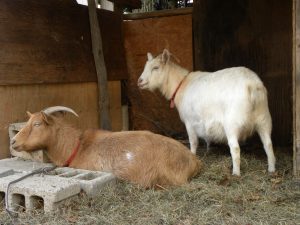
Honey (orange) and Lily (white)
I’m taking an online class about natural goatkeeping and kidding from Deborah Niemann, in preparation for our own kidding season. We have one pregnant doe, Lily, my favorite goat, who is due in mid-May!
My reading list is no where near done, but I have sent a lot of postcards to my representatives on many different issues.
Our Harvest in February
Egglaying really kicked in this month, with 156 chicken eggs and 34 duck eggs collected. Even with so little forage, the duck egg yolks are a deep orange.
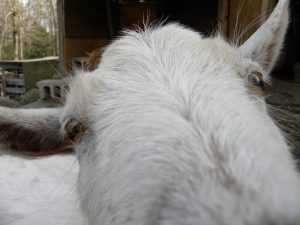
Close up of curious Lily goat
Milk continues to just trickle in. After 2 1/2 years in milk, Lily was “dried off” because of her pregnancy. She really led the process. Before initiating the dry off myself, her supply just dropped off to almost nothing over a couple of weeks. Her body knew what to do! We did get 5 gallons this month, enough to keep making yogurt, which is the most important dairy product to me.
My salt making yielded 2 cups of salt in February. It’s delicious – extra strong salt taste for some reason. It should last even longer because we won’t need to use as much of it.
The winter honey extraction yielded 20 pounds.
Steve ate about a dozen lemons from his little potted tree in the living room.
We continued to eat from last year’s preserved harvest. We saw the end of our parsnips, dehydrated beans and grapes. All other supplies are holding out.
Our wood supply remains abundant, and our solar panel gain grows with the sun. In fact, I took some notes so I can tell you that we made 217 kwh of electricity this month. March should be much better.
We also started capturing another resource on the farm: our urine. I know, I know – ick, you probably say. But, let’s get past that and look at some information. We had an amazing presentation by Dave Cedarholm, the founder of Pee Local in NH based on the work of The Rich Earth Institute. We learned about the terrible effects of excess nitrogen running into Great Bay, a significant percentage of it from human urine. Wastewater treatment plants are undergoing expensive upgrades to try to remove the nitrogen, and typical home septic systems do nothing to remove it. However, if it is captured by itself rather than mixed with other waste, it is a safe, effective and cheap fertilizer. Applied to growing plants and active soil, it is happily and appropriately used.

Supplies for setting up our home urine diversion program
This is a perfect example of our permaculture tenet to Turn Problems Into Solutions as well as Principles 5 (Use and Value Renewable Resources) and 6 (Produce No Waste)!
So, we are collecting and storing our urine for use during the growing season. Steve is learning to make “sitz-pees” that make it easy for women to do so, since we don’t yet have commercially made urine diverting toilets available in the US. I can tell you that it felt weird to use for about 3 days, and now I can’t imagine doing anything else. I feel bad when I have to use the bathroom away from home to be wasting this resource!
February is behind us and coming up in March, I will start many more seeds, prune our trees, bushes, grapes and brambles, keep making salt, and we’ll see what else comes up!
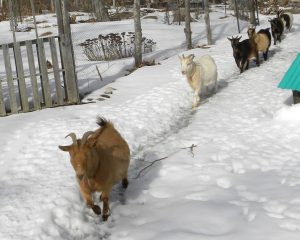
Goats returning to the barn after foraging

